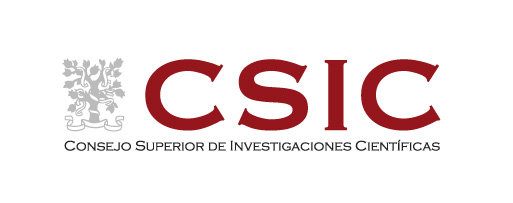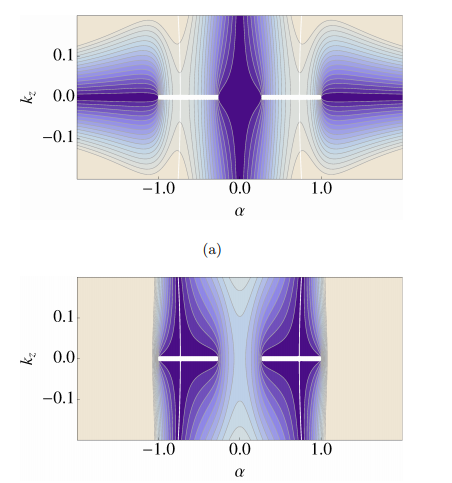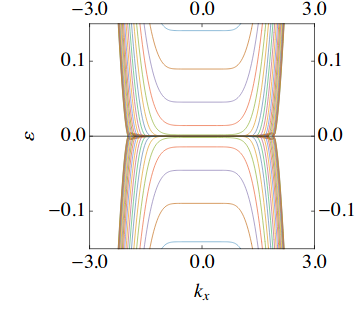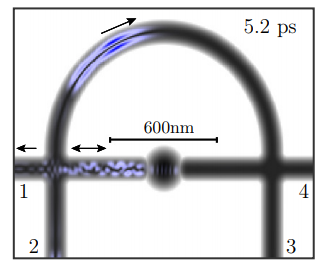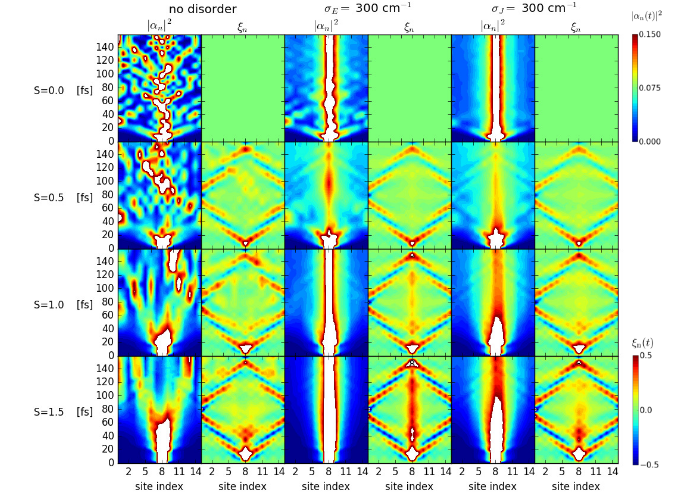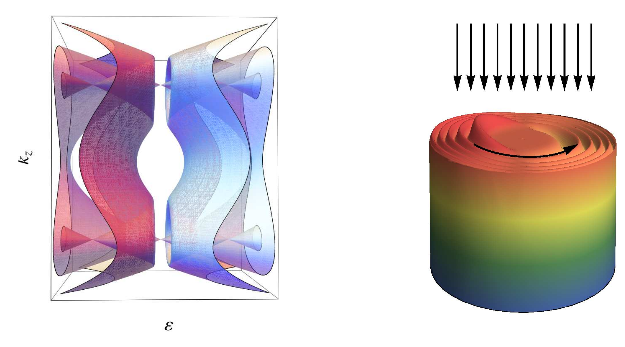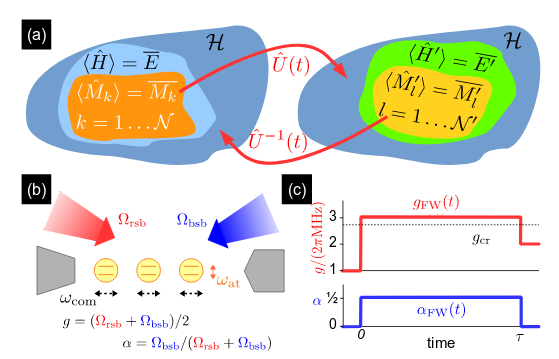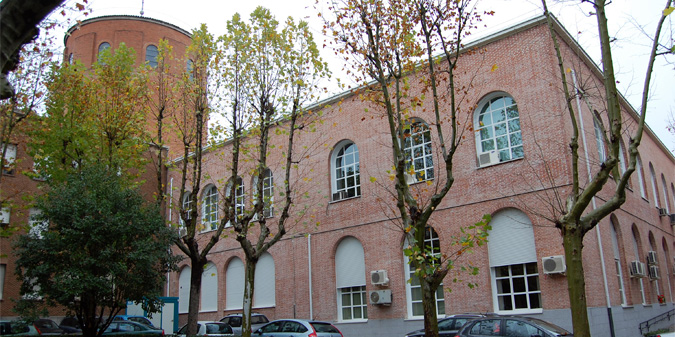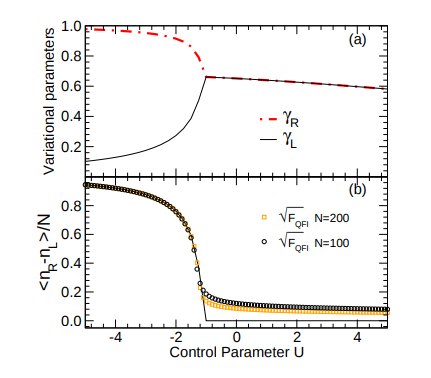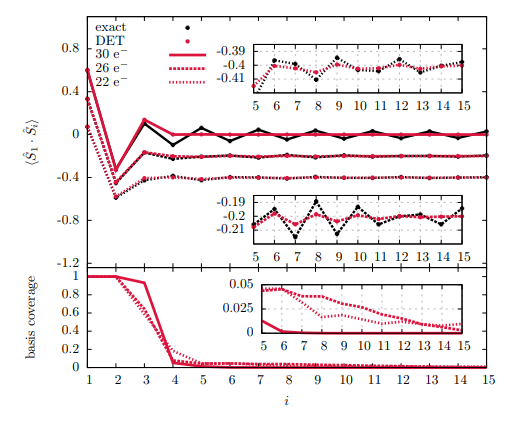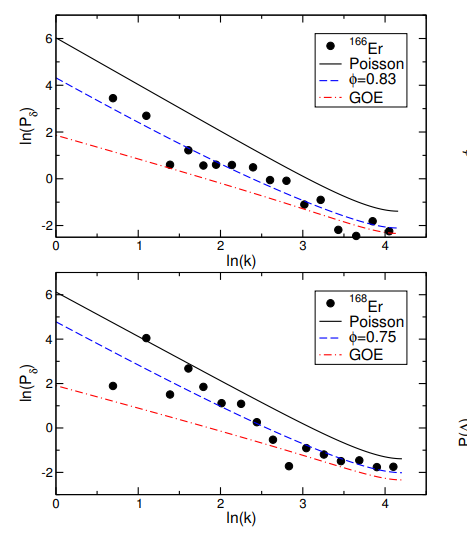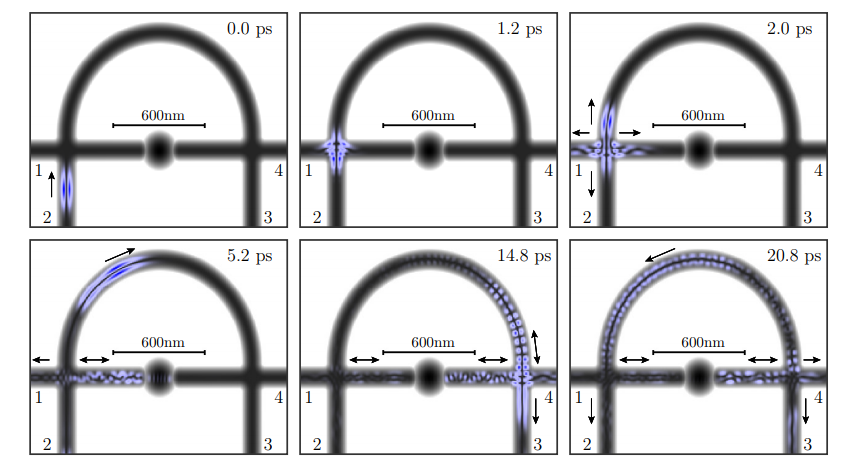Publications
2021, 2020, 2019, 2018, 2017, 2016, 2015, 2014, 2013, 2012, 2011, 2010
2021
- Variational determination of ground and excited-state two-electron reduced density matrices in the doubly occupied configuration space: A dispersion operator approach
D.R. Alcoba, O.B. Oña, L. Lain, A. Torre, P. Capuzzi, G.E. Masaccesi, E. Ríos, A. Rubio-García, J. Dukelsky
J. Chem. Phys. 154, 224104 (2021)
Repositorio digital MINCYT
- Signatures of a critical point in the many-body localization transition
A.L. Corps, R.A. Molina, A. Relaño
SciPost Phys. 10, 107 (2021)
- Rashba coupling and spin switching through surface states of Dirac semimetals
Y. Baba, F. Domínguez-Adame, G. Platero, R.A. Molina
New J. Phys. 23, 023008 (2021)
- Accuracy and precision of the estimation of the number of missing levels in chaotic spectra using long-range correlations
I. Casal, L. Muñoz, R.A. Molina
Eur. Phys. J. Plus 136, 236 (2021)
arXiv:2011.01667
2020
- Van Hove bound states in the continuum: Localised subradiant states in finite open lattices
J. Mur-Petit, R.A. Molina
Phys. Rev. B 101, 184306 (2020)
arXiv:2002.05959
- Transition between anomalous and Anderson localization in systems with non-diagonal disorder driven by time-periodic fields
R.A. Molina, V.A. Gopar
Eur. Phys. J B 93, 76 (2020)
arXiv:2003.06372
- Topological bulk states and their currents
C.N. Self, A. Rubio-García, J. García-Ripoll, J.K. Pachos
Phys. Rev. B 102, 045424 (2020)
arXiv:1906.01705
- Time-reversal versus chiral symmetry breaking in twisted bilayer graphene
J. González, T. Stauber
Phys. Rev. B 102, 081118 (2020)
arXiv:2002.12039
- Thouless Energy Challenges Thermalization on the Ergodic Side of the Many-Body Localization Transition
A.L. Corps, R.A. Molina, A. Relaño
Phys. Rev. B 102, 014201 (2020)
arXiv:2001.03990
- Surface and bulk Landau levels in thin films of Weyl semimetals
E. Benito-Matías, R.A. Molina, J. González
Phys. Rev. B 101, 085420 (2020)
arXiv:1907.05668
- Seeing topological edge and bulk currents in time-of-flight images
A. Rubio-García, C.N. Self, J. García-Ripoll, J.K. Pachos
Phys. Rev. B 102, 041123 (2020)
arXiv:1910.06446
- Change of chirality at magic angles of twisted bilayer graphene
T. Stauber, J. González, G. Gómez-Santos
Phys. Rev. B 102, 081404(R) (2020)
arXiv:2004.08931
- Efficient computation of matrix elements of generic Slater determinants
J. Rodriguez-Laguna, L.M. Robledo, J. Dukelsky
Phys. Rev. A 101, 012105 (2020)
arXiv:1909.12634
- Marginal Fermi liquid in twisted bilayer graphene
J. González, T. Stauber
Phys. Rev. Lett. 124, 186801 (2020)
arXiv:1903.01376
- Photoprotected spin Hall effect on graphene with substrate induced Rashba spin–orbit coupling
A. López, R.A. Molina
J. Phys: Condensed Matter 32, 205701 (2020)
arXiv:2003.01779
- Fluctuations of work in realistic equilibrium states of quantum systems with conserved quantities
J. Mur-Petit, A. Relaño, R.A. Molina, D. Jaksch
SciPost Phys. Proc. 3, 024 (2020)
2019
- Kohn-Luttinger Superconductivity in Twisted Bilayer Graphene
J. González, T. Stauber
Phys. Rev. Lett. 122, 026801 (2019)
arXiv:1807.01275
- Variational reduced density matrix method in the doubly-occupied configuration interaction space using four-particle N-representability conditions: Application to the XXZ model of quantum magnetism
A. Rubio-García, J. Dukelsky, D.R. Alcoba, P. Capuzzi, O.B. Oña, E. Ríos, A. Torre, L. Lain
J. Chem. Phys. 151, 154104 (2019) Digital CSIC
- An extended Agassi model: Algebraic structure, phase diagram and large size limit
J.E. García-Ramos, J. Dukelsky, P. Pérez-Fernández, J.M. Arias
Physica Scripta 94, 4 (2019) Digital CSIC
- Integrable model of a p-wave bosonic superfluid
S. Lerma-Hernández, J. Dukelsky, G. Ortiz
Phys. Rev. Res. 1, 032012(R) (2019)
- Number conserving particle-hole RPA for superfluid nuclei
J. Dukelsky, J.E. García-Ramos, J.M. Arias, P. Pérez-Fernández, P. Schuck
Phys. Lett. B 795, 537 (2019)
arXiv:1810.10448
- Surface states in topological semimetal slab geometries
E. Benito-Matías, R.A. Molina
Phys. Rev. B 99, 075304 (2019)
arXiv:1906.12217
- Electric field manipulation of surface states in topological semimetals
Y. Baba, A. Díaz-Fernández, E. Díaz, F. Domínguez-Adame, R.A. Molina
Phys. Rev. B 100, 165105 (2019)
arXiv:1907.06516
2018
- Revealing missing charges with generalised quantum fluctuation relations
J. Mur-Petit, A. Relaño, R.A. Molina, D. Jaksch
Nature Communications 9, 2006 (2018)
- Topological phases in the Haldane model with spin-spin on-site interactions
A. Rubio-García, J.J. García-Ripoll
New J. Phys. 20, 043033 (2018)
- Seniority based energy renormalization group (Ω-ERG) approach in quantum chemistry: Initial formulation and application to potential energy surfaces
L. Bytautas, J. Dukelsky
Comp. Theor. Chem. 1141, 74 (2018)
Digital CSIC
- Experimental evidence of chaos in the bound states of 208Pb
L. Muñoz, R.A. Molina, J.M.G. Gómez, A. Heusler
J. Phys. Conf. Ser. 966, 012060 (2018)
- Chaos in nuclei: Theory and experiment
L. Muñoz, R.A. Molina, J.M.G. Gómez
J. Phys. Conf. Ser. 1023, 012011 (2018)
- Benchmarking the Variational Reduced Density Matrix Theory in the Doubly Occupied Configuration Interaction Space with Integrable Pairing Models
A. Rubio-García, D.R. Alcoba, P. Capuzzi, J. Dukelsky
J. Chem. Theory Comput. 14, 4183 (2018)
arXiv:1805.01322
- Surface and 3D quantum Hall effects from engineering of exceptional points in nodal-line semimetals
R.A. Molina, J. González
Phys. Rev. Lett. 120, 146601 (2018)
arXiv:1710.01960
2017
- Dynamics of coherence, localization and excitation transfer in disordered nanorings
A.D. Somoza, Ke-Wei Sun, R.A. Molina, Yang Zhao
Phys. Chem. Chem. Phys. 19, 25996 (2017).
arXiv:1707.01390
- Localization length versus level repulsion in 1-D driven disordered quantum wires
E. Benito-Matías, R.A. Molina
Phys. Rev. B 96, 174202 (2017)
arXiv:1711.00685
- Correlation between peak-height modulation and phase-lapses in transport through quantum dots
R.A. Jalabert, R.A. Molina, G. Weick, D. Weinmann
Phys. Rev. E 96, 062208 (2017)
arXiv:1710.01960
- Combining symmetry collective states with coupled-cluster theory: Lessons from the Agassi model Hamiltonian
M.R. Hermes, J. Dukelsky, G.E. Scuseria
Phys. Rev. C 95, 064306 (2017)
arXiv:1703.02123
- Competition between disorder and interaction effects in 3D Weyl semimetals
J. González
Phys. Rev. B 96, 081104(R) (2017)
arXiv:1703.02885
- Topological protection from exceptional points in Weyl and nodal line semimetals
J. González and R. A. Molina
Phys. Rev. B 96, 045437 (2017)
arXiv:1702.02521
- Examination of experimental evidence of chaos in the bound states of 208Pb
L. Muñoz, R.A. Molina, J.M.G. Gómez, A. Heusler
Phys. Rev. C 95, 014317 (2017)
arXiv:1605.00210
- Time-dependent transport simulations through Aharanov-Bohm rings with an embedded quantum dot
C. Kreisbeck, T. Kramer, R.A. Molina
Journal of Physics: Condensed Matter 29, 155301 (2017)
arXiv:1701.02976
News and views in Jphys+
- On the solution of a pairing problem in the continuum
A. Mercenne, N. Michel, J. Dukelsky, M. Ploszjaczak
Phys. Rev. C 95, 024324 (2017)
arXiv:1612.00308
2016
-
Polynomial similarity transformation theory: A smooth interpolation between coupled cluster doubles and projected BCS applied to the reduced BCS Hamiltonian.
M. Degroote, T. M. Henderson, J. M. Zhao, J. Dukelsky, and G. Scuseria
Phys. Rev. B 93, 125124 (2016)
arXiv:1512.06111
-
Structure of the number-projected BCS wave function
J. Dukelsky, S. Pittel, and C. Esebbag
Phys. Rev. C 94, 054622 (2016)
arXiv:1603.00642
-
Staircase of crystal phases of hard-core bosons on the kagome lattice
D. Huerga, S. Capponi, J. Dukelsky, G. Ortiz
Phys. Rev. B 94, 165124 (2016)
arXiv:1607.07381
-
Excited-state quantum phase transition in the two-spin elliptic Gaudin model
A. Relaño, C. Esebbag, J. Dukelsky
Phys. Rev. E 94, 052110 (2016)
-
Confining and repulsive potential from effective non-Abelian gauge fields in graphene bilayers
J. González
Phys. Rev. B 94, 165401 (2016)
arXiv:1609.04968
-
Macroscopic degeneracy of zero-mode rotating surface states in 3D Dirac and Weyl semimetals under radiation.
J. González, R.A. Molina
Phys. Rev. Lett. 116, 156803 (2016)
arXiv:1512.03753
Noticias en los medios de comunicación
-
Superradiance at the localization-delocalization crossover in tubular chlorosomes
R.A. Molina, E. Benito-Matías, A.D. Somoza, L. Chen, and Y. Zhao
Phys. Rev. E 93, 022414 (2016)
arXiv:1601.04728
-
Generic helical edge states due to Rashba spin-orbit coupling in a topological insulator
L. Ortiz, R.A. Molina, G. Platero, A.M. Lunde
Phys. Rev. B 93, 205431 (2016)
arXiv:1509.09183
2015
-
Integrable Richardson-Gaudin models in mesoscopic physics
J. Dukelsky
Romanian Journal of Physics 60, 753 (2015)
-
The elliptic Gaudin model: a numerical study
C. Esebbag, J. Dukelksy
J. Phys. A: Math. Theor. 49, 475303 (2015)
arXiv:1509.01451
-
Shell model studies of chaos and statistical properties in nuclei
J.M.G. Gómez, E. Faleiro, L. Muñoz, R.A. Molina, A. Relaño
J. Phys. Conf. Series 580, 012045 (2015)
-
Phase diagram of the quantum electrodynamics of 2D and 3D Dirac semimetals
J. González
Phys. Rev. B 92, 125115 (2015)
arXiv:1502.07640
-
Strong-coupling phases of 3D Dirac and Weyl semimetals. A renormalization group approach
J. González
JHEP 10, 190 (2015)
arXiv:1509.00210
-
Advanced density matrix renormalization group method for nuclear structure calculations
O. Legeza, L. Veis, A. Poves, J. Dukelsky
Phys. Rev. B 92, 051303 (2015)
arXiv:1507.00161
-
Measuring molecular electric dipoles using trapped atomic ions and ultrafast laser pulses
J. Mur-Petit, J.J. García-Ripoll
Phys. Rev. B 91, 012504 (2015)
arXiv:1306.1416
-
Spectral statistics of molecular resonances in erbium isotopes: How chaotic are they?
J. Mur-Petit, R.A. Molina
Phys. Rev. E 92, 042906 (2015)
arXiv:1506.08086
-
Improvement to the projected BCS approximation
S. Pittel, C. Esebbag, J. Dukelksy
J. Phys. Conf. Series 639, 012009 (2015)
-
Density-dependent synthetic magnetism for ultracold atoms in optical lattices
S. Greschner, D. Huerga, G. Sun, D. Poletti, L. Santos
Phys. Rev. B 92, 115120 (2015)
arXiv:1502.07944
2014
Lattice Scars: Surviving in an open discrete billiard
V. Fernández-Hurtado, J. Mur-Petit, J.J. García-Ripoll, R.A. Molina
New J. Phys. 16, 035005 (2014)
arXiv:1305.5370
Collective modes of a trapped ion-dipole system:Towards measuring, controlling and entangling electric dipoles with atomic ions
J. Mur-Petit, J.J. García-Ripoll
Appl. Phys. B 114, 283-294 (2014)
arXiv:1306.2773
Chiral bound states in the continuum
J. Mur-Petit, R.A. Molina
Phys. Rev. B 90, 035434 (2014)
The Lipkin-Meshkov-Glick model from the perspective of the SU(1,1) Richardson-Gaudin models
S. H. Lerma, J. Dukelsky
J. Phys.: Conf. Ser. 492, 012013 (2014)
Density matrix embedding from broken symmetry lattice mean fields
I. W. Bulik, G. E. Scuseria, J. Dukelsky
Physical Review B 89, 035140 (2014)
Chiral phases of two-dimensional hard-core bosons with frustrated ring exchange
D. Huerga, J. Dukelsky, N. Laflorencie, G. Ortiz
Physical Review B 89, 094401 (2014)
arXiv:1312.0419
Quasiparticle coupled cluster theory for pairing interactions
T. M. Henderson, G. E. Scuseria, J. Dukelsky, A. Signoracci, T. Duguet
Physical Review C 89, 054305 (2014)
Phase stabilization of a frequency comb using multi-pulse quantum interferometry
A. Cadarso, J. Mur-Petit, J.J. García-Ripoll
Phys. Rev. Lett. 112, 073603 (2014)
Marginal Fermi liquid versus excitonic instability in 3D Dirac semimetals
J. González
Physical Review B 90, 121107(R) (2014)
Rippling transition from electron-induced condensation of curvature field in graphene
J. González
Physical Review B 90, 165402 (2014)
2013
-
Mesoscopic behavior of the transmission phase through confined correlated electronic systems
Rafael A. Molina, Peter Schmitteckert, Dietmar Weinmann, Rodolfo A. Jalabert, Philippe Jacquod
Phys. Rev. B 88, 045419(2013)
-
The Lipkin-Meshkov-Glick model as a particular limit of the SU(1, 1) Richardson-Gaudin integrable models.
S. Lerma, J. Dukelsky.
Nucl. Phys. B 870, 421 (2013).
-
Exact solutions for pairing interactions.
J. Dukelsky, S. Pittel.
"50 Years of Nuclear BCS" , eds. R.A.Broglia, V.Zelevinsky. World Scientific Publishing Co., Singapore(2013) pp. 200-211.
-
Composite Boson Mapping for Lattice Boson Systems.
D. Huerga, J. Dukelsky, G. E. Scuseria.
Phys. Rev. Lett. 111, 045701 (2013).
-
Repulsive interactions in quantum Hall systems as a pairing problem.
G. Ortiz, Z. Nussinov, J. Dukelsky, y A. Seidel.
Phys. Rev. B 88, 165303 (2013).
-
A Beyond Mean Field study of Bose gases in a double-well potential with a Feshbach resonance
P. Pérez-Fernández, A. Relaño, J. Dukelsky, J. M. Arias
AIP Conference Proceedings Vol. 1541, 187-188 (2013)
-
Magnetic and Kohn-Luttinger instabilities near a Van Hove singularity: monolayer versus twisted bilayer graphene
J. González
Physical Review B 88, 125434 (2013)
-
Dynamical breakdown of parity and time-reversal invariance in the many-body theory of graphene
J. González
Journal of High Energy Physics 07, 175 (2013)
-
Many-body dynamics of p-wave Feshbach molecule production: a mean-field approach
L. Austen, L. Cook, M. D. Lee, J. Mur-Petit
Phys. Rev. A 87, 023610 (2013)
-
Simulating the Dirac field with cold atoms in a honeycomb lattice
E. Alba, X. Fernandez-Gonzalvo, J. Mur-Petit, J. J. García-Ripoll, J. K. Pachos
Ann. Phys. 328, 64 (2013)
-
Cumulant dynamics of strongly interacting ultracold gases and Feshbach molecule formation
T.M. Hanna, J. Mur-Petit
Chapter 7 (pp. 121-131) in Quantum Gases: Finite Temperature and Non-Equilibrium Dynamics
N. P. Proukakis, S. A. Gardiner, M. J. Davis, and M. H. Szymanska (eds.)
Imperial College Press: London (Cold Atoms Series, vol. 1), 2013
2012
-
Non-Abelian gauge potentials in graphene bilayers
P. San-José, J. González and F. Guinea
Physical Review Letters 108, 216802 (2012)
-
Electron self-energy effects on chiral symmetry breaking in graphene
J. González
Physical Review B 85, 085420 (2012)
-
Higher-order renormalization of graphene many-body theory
J. González
Journal of High Energy Physics 08, 27 (2012)
-
AC Josephson effect in finite-length nanowire junctions with Majorana modes
P. San-José, E. Prada, R. Aguado
Physical Review Letters 108, 257001 (2012)
-
Laser-induced quantum pumping in graphene
P. San-José, E. Prada, H. Schomerus, S. Kohler
Applied Physics Letters 101, 153506 (2012)
-
Transport spectroscopy of N-S nanowire junctions with Majorana fermions
E. Prada, P. San-José, R. Aguado
Physical Review B 86, 180503 (2012)
-
Scattering phase thorugh quantum dots: Emergence of universal behavior
R.A. Molina, R.A. Jalabert, D. Weinmann, Ph. Jacquod
Phys. Rev. Lett. 108, 076803 (2012)
-
Quartet condensation and isovector pairing correlations in N=Z Nuclei
N. Sandliescu, D. Negrea, J. Dukelsky, C.W. Johnson
Phys. Rev. C 85, 061303(R) (2012)
-
Integrable Richardson-Gaudin models in mesoscopic physics
J. Dukelsky
J. Phys.: Conf. Ser. 338 (2012) 012023
-
Excited state quantum phase transitions and chaos in the Dicke model
P. P&ecute;rez-Fernández, A. Relaño, P. Cejnar, J.M. Arias, J. Dukelsky and J.E. García-Ramos
AIP Conference Proceedings, 1488 (2012) 318
-
Decoherence and quantum quench: their relationship with excited state quantum phase transitions
J. E. García-Ramos, J. M. Arias, P. Cejnar, J. Dukelsky, P. Pérez-Fernández, y A. Relaño
AIP Conference Proceedings, 1488 (2012) 309
-
New realizations of the Richardson-Gaudin models in nuclear physics: the hyperbolic model
J. Dukelsky and S. Lerma
AIP Conference Proceedings, 1488 (2012) 182
-
Isovector pairing and quartet condensation in N=Z Nuclei
N. Sandulescu, D. Negrea, J. Dukelsky, C.W. Johnson
AIP Conference Proceedings, 1498 (2012) 359
-
Embedding method for the scattering phase in strongly correlated quantum dots
R.A. Molina, P. Schmitteckert, D. Weinmann, R.A. Jalabert, Ph. Jacquod
J. Phys.: Conf. Ser. 338 (2012) 012011
-
Apunts de Física 2010
J. Mur
Revista de Física 4(8), 31-33 (2012)
-
Towards a molecular ion qubit
J. Mur-Petit, J. Pérez-RÃíos, J. Campos- Martínez, M. I. Hernández, S. Willitsch, J. J. García-Ripoll
Architecture and Design of Molecule Logic Gates and Atom Circuits, N. Lorente and C. Joaquim (eds.),
Proceedings of the 2nd AtMol European Workshop, Springer (Heidelberg), Advances in Atom and Single-Molecule Machines Series (2012). ISBN: 978-3642331367.
2011
-
Electron-induced rippling in graphene
P. San-José, J. González and F. Guinea
Physical Review Letters 106, 045502 (2011)
-
Progress in modeling graphene: The novel features of this material
F. Guinea, M. A. H. Vozmediano, M. P. López-Sancho and J. González
Advanced Materials 23, 5324 (2011)
-
Gate driven adiabatic quantum pumping in graphene
E. Prada, P. San-Jos&ecute;, H. Schomerus
Solid State Communications 151, 1065 (2011)
-
Band topology and the quantum spin Hall effect in bilayer graphene
E. Prada, P. San-Joé, L. Brey, H. A. Fertig
Solid State Communications 151, 1075 (2011)
-
Single-parameter pumping in graphene
P. San-José, E. Prada, S. Kohler, H. Schomerus
Physical Review B 84, 155408 (2011)
-
Many-Body quantum chaos: Recent developments and applications to nuclei
J.M.G. Gómez, K. Kar, V.K.B. Kota, R.A. Molina, A. Relaño, and J. Retamosa
Physics Reports 499, 103 (2011)
-
Recent results on quantum chaos and its applications to atomic nuclei
J.M.G. Gómez, E. Faleiro, L. Muñoz, R.A. Molina, A. Relaño, and J. Retamosa
Journal of Physics: Conference Series 267, 012061 (2011)
-
Tailored particle current in an optical lattice by a weak time-symmetric harmonic potential
J. Santos, R.A. Molina, J. Ortigoso, M. Rodríguez
Physical Review A 84, 023614 (2011)
-
Quantum quench influenced by an excited-state phase
transition
P. Pérez Fernández, P. Cejnar, J.M. Arias,
J. Dukelsky, J.E. García-Ramos, A. Relano
Physical Review A 83, 033802 (2011)
-
Excited-state phase transition and onset of chaos in quantum
optical models
P. P&ecuate;rez Fernández, A. Relaño, J.M. Arias, P. Cejnar
J. Dukelsky, J.E. Garcia-Ramos
Physical Review E 83, 046208 (2011)
-
Comment on "Fermi-Bose Mixtures near Broad Interspecies
Feshbach. Resonances"
J. Dukelsky, C. Esebbag, P. Schuck, T. Suzuki
Physical Review Letters 106, 129601 (2011)
-
Integrable two-channel px+ipy-wave model of a
superfluid.
S. Lerma H., S. M. A. Rombouts,
J. Dukelsky,G. Ortiz
Physical Review B 84, 100503(R) (2011).
-
Exactly solvable pairing Hamiltonian for heavy nuclei.
J. Dukelsky, S. Lerma H., L. M. Robledo, R. Rodriguez-Guzman, and S. M. A. Rombouts.
Physical Review B 84, 100503(R) (2011).
-
Richardson-Gaudin models: the hyperbolic
family.
J. Dukelsky, S. Rombouts, G. Ortiz
Journal of
Physics: Conference Series 321, 012001 (2011).
2010
-
Pairing in 4-component fermion systems: The bulk limit of SU(4)-symmetric Hamiltonians
G. F. Bertsch, J. Dukelsky, B. Errea and C. Esebbag
Annals of Physics 325, 1340 (2010)
-
Prediction of resonant all-electric spin pumping with spin-orbit coupling
V. Brosco, M. Jerger, P. San-José, G. Zarand, A. Shnirman and G. Schön
Physical Review B 82, 041309(R) (2010)
-
Renormalization group approach to chiral symmetry breaking in graphene
J. González
Physical Review B 82, 155404 (2010)
-
Graphene wormholes: A condensed matter illustration of Dirac fermions in curved space
J. González and J. Herrero
Nuclear Physics B 825, 426 (2010)
-
Controlling the conductance statistics of quantum wires by driving ac fields
V. A. Gopar, R. A. Molina
Physical Review B 81, 195415 (2010)
-
Interplay of Tomonaga-Luttinger liquids and superconductive phase in carbon nanotubes
J. Haruyama, J. González, E. Perfetto, E. Einarson, S. Maruyama and H. Shinohara
Europhysics Letters 89, 27003 (2010)
-
Phase diagram of the Heisenberg antiferromagnet with four-spin interactions
L. Isaev, G. Ortiz and J. Dukelsky
Journal of Physics: Condensed Matter 22, 016006 (2010)
-
Comment on a Quantum phase transition in the four-spin exchange antiferromagnet
L. Isaev, G. Ortiz, J. Dukelsky
Physical Review B 82, 136401 (2010)
-
Extended van Hove singularity and superconducting instability in doped graphene
J. L. McChesney, A. Bostwick, T. Ohta, T. Seyller, K. Horn, J. González and E. Rotenberg
Physical Review Letters 104, 136803 (2010)
-
Perspectives on 1/f noise in quantum chaos
R. A. Molina, A. Relaño, J. Retamosa, L. Muñoz, E. Faleiro and J. M. G. Gómez
Journal of Physics: Conference Series 239, 012001 (2010)
-
Connection between decoherence and excited state quantum phase transitions
P. Pérez-Fernández, A. Relaño, J. M. Arias, J. E. García-Ramos, J. Dukelsky
AIP Conference Proceedings 1231, 233-234 (2010)
-
Singular elastic strains and magnetoconductance of suspended graphene
E. Prada, P. San-José, G. León, M. M. Fogler and F. Guinea
Physical Review B 81, 161402(R) (2010)
-
Zero Landau Level in Folded Graphene Nanoribbons
E. Prada, P. San-José, L. Brey
Physical Review Letters 105, 106802 (2010)
-
Quantum phase diagram of the integrable px+ipy fermionic superfluid
S. M. A. Rombouts, J. Dukelsky, G. Ortiz
Physical Review B 82, 224510 (2010)
-
Color-charge separation in trapped SU(3) fermionic atoms
T. Ulbricht, R. A. Molina, R. Thomale, P. Schmitteckert
Physical Review A 82, 011603(R) (2010)
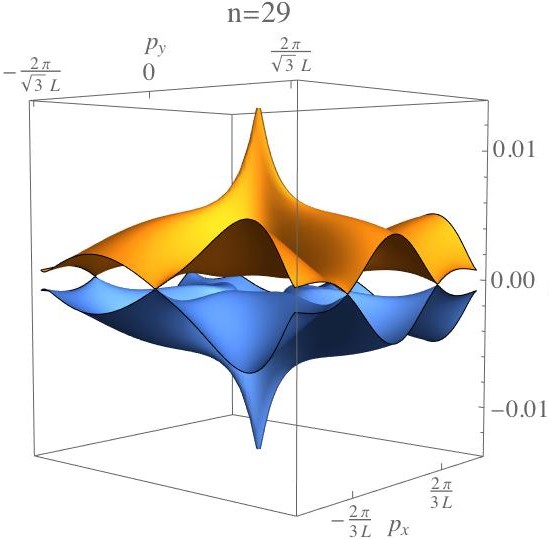
 csic.es
csic.es iem.cfmac.csic.es
iem.cfmac.csic.es csic.es
csic.es csic.es
csic.es csic.es
csic.es